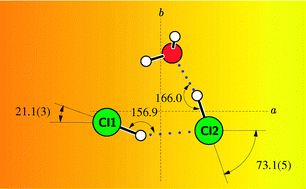Structure and properties of the (HCl)2H2O cluster observed by chirped-pulse Fourier transform microwave spectroscopy†
Abstract
The

- This article is part of the themed collection: Weak hydrogen bonds – strong effects?
* Corresponding authors
a
Institute of Physics, Polish Academy of Sciences, Al. Lotników 32/46, 02-668 Warszawa, Poland
E-mail:
kisiel@ifpan.edu.pl
Fax: 048-22-8430926
b Departamento de Química Física y Química Inorgánica, Facultad de Ciencias, Universidad de Valladolid, E-47011 Valladolid, Spain
c Department of Chemistry, University of Virginia, McCormick Rd., P.O. Box 400319, Charlottesville, Virginia, USA
The

 Please wait while we load your content...
Something went wrong. Try again?
Please wait while we load your content...
Something went wrong. Try again?
Z. Kisiel, A. Lesarri, J. L. Neill, M. T. Muckle and B. H. Pate, Phys. Chem. Chem. Phys., 2011, 13, 13912 DOI: 10.1039/C1CP20841A
To request permission to reproduce material from this article, please go to the Copyright Clearance Center request page.
If you are an author contributing to an RSC publication, you do not need to request permission provided correct acknowledgement is given.
If you are the author of this article, you do not need to request permission to reproduce figures and diagrams provided correct acknowledgement is given. If you want to reproduce the whole article in a third-party publication (excluding your thesis/dissertation for which permission is not required) please go to the Copyright Clearance Center request page.
Read more about how to correctly acknowledge RSC content.
 Fetching data from CrossRef.
Fetching data from CrossRef.
This may take some time to load.
Loading related content
